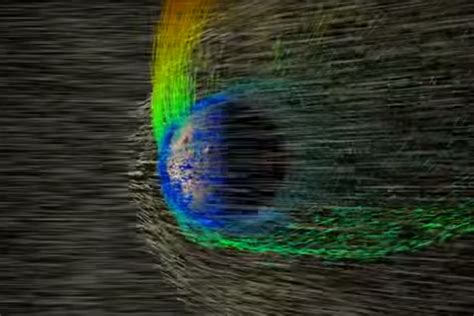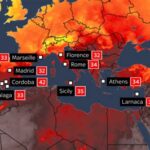
Mars’ atmosphere continues to thin, with new evidence confirming that solar wind is a primary culprit in stripping away atmospheric gases, scientists have found. Data gathered over several years by NASA’s MAVEN (Mars Atmosphere and Volatile Evolution) spacecraft provides the most comprehensive picture yet of how the solar wind, a stream of charged particles emanating from the Sun, is eroding the Martian atmosphere, leading to its transformation from a potentially habitable environment billions of years ago to the cold, arid planet we observe today.
Scientists now have more conclusive evidence of the direct link between solar wind and atmospheric loss on Mars. This process, occurring over eons, has significantly diminished the planet’s protective shield, making the surface inhospitable. “The solar wind is continuously impacting Mars’ atmosphere,” said researchers involved in the MAVEN mission. “This interaction is a major driver of atmospheric loss to space, changing the planet’s climate over geological time.” The findings reinforce the understanding of Mars’ past and future habitability prospects.
The MAVEN mission, launched in 2013, was designed to explore the upper atmosphere of Mars and to understand the mechanisms responsible for the loss of atmospheric gases to space. Over the course of its mission, MAVEN has directly observed the ongoing stripping of Mars’ atmosphere by the solar wind. The observations indicate that the solar wind’s electric field can pick up ions in Mars’ upper atmosphere and accelerate them away from the planet. This process is particularly effective during solar storms, when the Sun emits increased amounts of energy and particles.
The Role of Solar Wind
The solar wind is a constant stream of charged particles, primarily protons and electrons, that flows outward from the Sun at speeds of hundreds of kilometers per second. It carries with it a magnetic field that can interact with the magnetic fields of planets. Unlike Earth, Mars lacks a global magnetic field, leaving its atmosphere directly exposed to the solar wind.
When the solar wind encounters Mars, its magnetic field can interact with the planet’s ionosphere, the layer of ionized gas in the upper atmosphere. This interaction can create an electric field that accelerates ions, such as oxygen and carbon, away from the planet. Over billions of years, this process can lead to a significant loss of atmospheric gases, particularly lighter elements such as hydrogen.
“We’ve long suspected that the solar wind plays a significant role in the erosion of the Martian atmosphere,” stated a lead scientist on the MAVEN mission. “Now, with the data collected by MAVEN, we have definitive evidence of the mechanisms at work and the rates at which gases are being lost.”
The rate of atmospheric loss varies depending on solar activity. During solar storms, the solar wind is more intense, and the rate of atmospheric loss increases dramatically. MAVEN has observed instances where the rate of atmospheric loss increased by a factor of ten or more during solar storms.
Implications for Mars’ Habitability
The thinning of Mars’ atmosphere has had profound implications for the planet’s habitability. Billions of years ago, Mars is believed to have had a much thicker atmosphere and a warmer, wetter climate. Evidence from Martian rocks and minerals suggests that liquid water was once abundant on the surface of Mars, potentially creating conditions suitable for life.
However, as the atmosphere thinned, the planet cooled, and liquid water became unstable on the surface. Today, Mars is a cold, dry desert with a thin atmosphere that is primarily composed of carbon dioxide. The atmospheric pressure on Mars is only about 1% of that on Earth, making it difficult for liquid water to exist on the surface.
“The loss of Mars’ atmosphere is a key factor in its transition from a potentially habitable planet to the inhospitable world we see today,” explained a planetary scientist. “Understanding the mechanisms that drive atmospheric loss is crucial for understanding the past and future habitability of Mars.”
The findings from the MAVEN mission also have implications for the search for life beyond Earth. If a planet’s atmosphere is vulnerable to erosion by the solar wind, it may be less likely to retain the conditions necessary for life to evolve and thrive. This highlights the importance of planetary magnetic fields in protecting atmospheres and maintaining habitable conditions.
MAVEN’s Discoveries and Measurements
MAVEN carries a suite of instruments designed to study the composition, structure, and dynamics of Mars’ upper atmosphere. These instruments include:
- Solar Wind Electron Analyzer (SWEA): Measures the energy and direction of solar wind electrons.
- Solar Wind Ion Analyzer (SWIA): Measures the energy and direction of solar wind ions.
- SupraThermal And Thermal Ion Composition (STATIC): Measures the composition and energy of thermal and suprathermal ions in the Martian atmosphere.
- Magnetometer (MAG): Measures the strength and direction of the magnetic field around Mars.
- Langmuir Probe and Waves (LPW): Measures the density and temperature of electrons in the Martian ionosphere.
- Neutral Gas and Ion Mass Spectrometer (NGIMS): Measures the composition of neutral gases and ions in the Martian atmosphere.
- Ultraviolet Spectrometer (IUVS): Measures the abundance of various gases in the Martian atmosphere by observing their ultraviolet emissions.
These instruments have provided a wealth of data about the Martian atmosphere and its interaction with the solar wind. MAVEN has directly observed the stripping of atmospheric gases by the solar wind, measured the rates at which different gases are being lost, and identified the key mechanisms responsible for atmospheric loss.
One of MAVEN’s key findings is that the solar wind’s electric field can accelerate ions in Mars’ upper atmosphere to escape velocities. This process is particularly effective for lighter ions, such as hydrogen and oxygen, which are more easily accelerated to escape velocity.
MAVEN has also observed that the rate of atmospheric loss varies depending on solar activity. During solar storms, the solar wind is more intense, and the rate of atmospheric loss increases dramatically. This suggests that solar storms play a significant role in the long-term erosion of the Martian atmosphere.
Future Research
The MAVEN mission is ongoing, and scientists continue to analyze the data collected by the spacecraft. Future research will focus on refining our understanding of the mechanisms responsible for atmospheric loss and on modeling the long-term evolution of the Martian atmosphere.
Scientists are also interested in studying the interaction of the solar wind with other planets and moons in our solar system. This research could help us to understand the factors that determine the habitability of planets and the prevalence of life beyond Earth.
“The MAVEN mission has revolutionized our understanding of the Martian atmosphere and its interaction with the solar wind,” said a NASA spokesperson. “The data collected by MAVEN will continue to be analyzed for years to come, and it will undoubtedly lead to new discoveries about Mars and its potential for habitability.”
The study of Mars’ atmosphere is not only relevant to understanding the past and future of Mars but also provides valuable insights into the processes that shape the atmospheres of other planets, including our own. By studying the evolution of planetary atmospheres, we can better understand the conditions necessary for life to arise and thrive in the universe.
Understanding Atmospheric Escape Processes
Atmospheric escape is the loss of atmospheric gases to space. This process can occur through several different mechanisms, including:
-
Thermal escape: This is the process by which atmospheric gases gain enough thermal energy to overcome the planet’s gravity and escape into space. Thermal escape is more effective for lighter gases, such as hydrogen and helium, which have higher velocities at a given temperature.
-
Non-thermal escape: This is the process by which atmospheric gases are energized by non-thermal processes, such as solar wind interactions or chemical reactions, and gain enough energy to escape into space. Non-thermal escape can be effective for heavier gases, such as oxygen and carbon dioxide, which are not easily lost through thermal escape.
-
Sputtering: This is the process by which atmospheric gases are ejected from the planet’s surface by the impact of energetic particles, such as solar wind ions. Sputtering can be an important escape mechanism for planets with thin atmospheres and weak magnetic fields.
On Mars, all three of these escape mechanisms are thought to play a role in the loss of atmospheric gases. However, the MAVEN mission has shown that non-thermal escape, particularly the stripping of atmospheric gases by the solar wind, is the dominant escape mechanism on Mars today.
Mars’ Geological History and Atmospheric Evolution
The geological history of Mars provides clues about the planet’s atmospheric evolution. Evidence suggests that Mars was once a much warmer and wetter planet with a thicker atmosphere. Ancient riverbeds, lakebeds, and deltas have been identified on the Martian surface, indicating that liquid water was once abundant.
The presence of liquid water suggests that Mars must have had a warmer climate and a thicker atmosphere in the past. A thicker atmosphere would have trapped more heat from the Sun, warming the planet and allowing liquid water to exist on the surface.
However, over time, Mars’ atmosphere has thinned, and the planet has cooled. The loss of atmosphere has been attributed to several factors, including the decline of Mars’ magnetic field, the impact of large asteroids, and the stripping of atmospheric gases by the solar wind.
The decline of Mars’ magnetic field left the planet’s atmosphere vulnerable to the solar wind. Without a global magnetic field, the solar wind could directly interact with the Martian atmosphere, stripping away atmospheric gases and causing the planet to cool.
The impact of large asteroids could also have contributed to the loss of Mars’ atmosphere. Large impacts can eject large amounts of atmosphere into space, causing the planet to cool and dry out.
The MAVEN mission has shown that the stripping of atmospheric gases by the solar wind is an ongoing process that is still contributing to the thinning of Mars’ atmosphere today.
Comparative Planetology: Earth vs. Mars
Comparing Earth and Mars provides valuable insights into the factors that determine the habitability of planets. Earth and Mars are similar in size and composition, but they have evolved in very different ways.
Earth has a thick atmosphere, a global magnetic field, and abundant liquid water on its surface. These factors have made Earth a habitable planet for billions of years.
Mars, on the other hand, has a thin atmosphere, a weak magnetic field, and very little liquid water on its surface. These factors have made Mars a cold, dry, and inhospitable planet.
The differences between Earth and Mars can be attributed to several factors, including the size of the planets, their distance from the Sun, and the presence or absence of a global magnetic field.
Earth is larger than Mars, which means that it has a stronger gravitational field. This stronger gravitational field has helped Earth to retain its atmosphere and liquid water.
Earth is also closer to the Sun than Mars, which means that it receives more solar energy. This solar energy has helped to keep Earth warm and liquid water stable on the surface.
Finally, Earth has a global magnetic field, which protects the planet from the harmful effects of the solar wind. Mars lacks a global magnetic field, which has left its atmosphere vulnerable to erosion by the solar wind.
By comparing Earth and Mars, we can better understand the factors that determine the habitability of planets and the prevalence of life beyond Earth.
The Search for Life on Mars
Despite its harsh conditions, Mars remains a prime target in the search for life beyond Earth. Evidence suggests that Mars was once a much more habitable planet with a thicker atmosphere and abundant liquid water.
If life ever arose on Mars, it may have adapted to the planet’s changing conditions and found refuge in subsurface environments, where liquid water may still exist.
NASA’s Perseverance rover is currently exploring Jezero Crater, a site that is believed to have once been a lake. Perseverance is collecting samples of Martian rocks and soil that will be returned to Earth for further analysis.
These samples could provide valuable clues about the history of Mars and the potential for life on the planet. If life is found on Mars, it would have profound implications for our understanding of the universe and our place in it.
The ongoing exploration of Mars is a testament to our curiosity and our desire to understand the universe around us. By studying Mars, we can learn more about the factors that determine the habitability of planets and the potential for life beyond Earth. The MAVEN mission is a crucial component of this exploration, providing essential information about the Martian atmosphere and its evolution.
FAQ: Mars’ Atmosphere and Solar Wind
1. What is the main finding of the recent research on Mars’ atmosphere?
The research confirms that the solar wind is a primary factor in stripping away Mars’ atmospheric gases, leading to a thinner atmosphere over billions of years. This supports the theory that Mars once had a thicker atmosphere and a warmer, wetter climate.
2. What role does the MAVEN spacecraft play in studying Mars’ atmosphere?
MAVEN (Mars Atmosphere and Volatile Evolution) is a NASA spacecraft designed to explore the upper atmosphere of Mars. It studies the mechanisms responsible for the loss of atmospheric gases to space and provides data on the solar wind’s interaction with the Martian atmosphere. MAVEN directly observes the ongoing stripping of Mars’ atmosphere by the solar wind.
3. How does the solar wind erode Mars’ atmosphere?
The solar wind, a stream of charged particles from the Sun, interacts with Mars’ ionosphere (the ionized layer of the upper atmosphere). This interaction creates an electric field that accelerates ions, like oxygen and carbon, away from the planet. Because Mars lacks a global magnetic field, its atmosphere is directly exposed to this effect.
4. Why is the loss of Mars’ atmosphere important for understanding its habitability?
The thinning of Mars’ atmosphere has significant implications for the planet’s habitability. A thicker atmosphere is believed to have supported liquid water on the surface, creating potentially habitable conditions. As the atmosphere thinned, the planet cooled, and liquid water became unstable, leading to the cold, arid Mars we know today.
5. What future research is planned based on the findings of the MAVEN mission?
Future research will focus on refining our understanding of the mechanisms responsible for atmospheric loss, modeling the long-term evolution of the Martian atmosphere, and studying the interaction of the solar wind with other planets and moons. This will help us understand planetary habitability and the potential for life beyond Earth.
Detailed Analysis of Atmospheric Loss Mechanisms
The Martian atmosphere, primarily composed of carbon dioxide (CO2), plays a critical role in regulating the planet’s temperature and pressure. However, over billions of years, Mars has lost a significant portion of its atmosphere, transforming from a potentially habitable world to a cold, arid desert. Understanding the mechanisms responsible for this atmospheric loss is crucial for unraveling the history of Mars and assessing its potential for past or present life.
Solar Wind Sputtering:
One of the primary mechanisms driving atmospheric loss on Mars is solar wind sputtering. The solar wind, a continuous stream of charged particles emanating from the Sun, interacts directly with the Martian atmosphere due to the absence of a global magnetic field. These energetic particles collide with atmospheric molecules, transferring energy and causing them to be ejected into space. This process, known as sputtering, is particularly effective at removing lighter elements such as hydrogen, oxygen, and nitrogen from the atmosphere.
Photochemical Escape:
Photochemical escape is another significant mechanism contributing to atmospheric loss on Mars. Ultraviolet (UV) radiation from the Sun can break down molecules in the upper atmosphere through a process called photodissociation. For example, UV radiation can split water molecules (H2O) into hydrogen (H) and hydroxyl (OH) radicals. The lighter hydrogen atoms can then escape into space due to their high thermal velocities. This process is particularly important for the loss of water from Mars, as water is a key ingredient for life.
Ion Pickup and Acceleration:
The solar wind’s electric field can also pick up ions in Mars’ upper atmosphere and accelerate them away from the planet. This process, known as ion pickup and acceleration, occurs when the solar wind’s electric field interacts with ionized atmospheric gases. The electric field exerts a force on the ions, accelerating them to escape velocities. This mechanism is particularly effective during solar storms, when the solar wind is more intense.
Impact Erosion:
While not a continuous process, impact erosion can also contribute to atmospheric loss on Mars. Large asteroid impacts can eject vast amounts of atmospheric gases into space. The kinetic energy of the impactor is transferred to the atmosphere, causing it to heat up and expand. Some of the atmosphere can then escape into space, reducing the overall atmospheric density.
The Role of Mars’ Weak Magnetic Field
Unlike Earth, which has a strong global magnetic field that deflects the solar wind, Mars has only a weak, localized magnetic field. This weak magnetic field provides little protection from the solar wind, leaving the Martian atmosphere vulnerable to erosion.
Billions of years ago, Mars is believed to have had a stronger global magnetic field, similar to Earth’s. However, this magnetic field dissipated over time, possibly due to the planet’s small size and rapid cooling. As the magnetic field weakened, the solar wind was able to interact more directly with the Martian atmosphere, accelerating atmospheric loss.
Modeling the Evolution of the Martian Atmosphere
Scientists use computer models to simulate the evolution of the Martian atmosphere over billions of years. These models take into account the various atmospheric loss mechanisms, as well as factors such as solar activity, volcanic outgassing, and impact events.
By comparing the results of these models with observations from spacecraft missions such as MAVEN, scientists can refine their understanding of the processes that have shaped the Martian atmosphere. These models can also be used to predict the future evolution of the Martian atmosphere and assess the potential for future habitability.
Implications for the Search for Life on Mars
The loss of Mars’ atmosphere has significant implications for the search for life on the planet. A thicker atmosphere would have provided greater protection from harmful radiation and helped to maintain a warmer, wetter climate. The thinning of the atmosphere has made it more difficult for liquid water to exist on the surface and increased the levels of radiation reaching the ground.
However, some scientists believe that life may still be possible on Mars, particularly in subsurface environments where liquid water may still exist. These environments would be shielded from the harsh conditions on the surface and could potentially provide a refuge for life.
Future Missions to Study Mars’ Atmosphere
Future missions to Mars will continue to study the planet’s atmosphere and search for evidence of past or present life. These missions will use advanced instruments to measure the composition, structure, and dynamics of the Martian atmosphere. They will also search for evidence of subsurface water and organic molecules.
By continuing to explore Mars, we can gain a better understanding of the processes that have shaped the planet’s atmosphere and assess its potential for life. The MAVEN mission is a critical component of this ongoing exploration, providing essential data about the Martian atmosphere and its interaction with the solar wind. The European Space Agency’s ExoMars Trace Gas Orbiter (TGO) is another mission studying the Martian atmosphere.
The broader context of planetary atmospheres and exoplanets
The study of Mars’ atmosphere also provides valuable insights into the atmospheres of other planets, including exoplanets – planets orbiting stars other than our Sun. Understanding the processes that shape planetary atmospheres is crucial for assessing the habitability of exoplanets and searching for signs of life beyond Earth.
Many exoplanets have been discovered in the habitable zones of their stars, meaning that they are at the right distance from their stars to potentially have liquid water on their surfaces. However, whether these exoplanets are actually habitable depends on a variety of factors, including the composition and thickness of their atmospheres.
By studying the atmospheres of planets in our solar system, such as Mars and Venus, we can gain a better understanding of the factors that determine the habitability of planets and the potential for life to arise and thrive in the universe.
Ongoing Monitoring and Data Analysis
The MAVEN mission continues to collect data on the Martian atmosphere, providing a long-term record of its evolution and interaction with the solar wind. Scientists are constantly analyzing this data to refine their understanding of the processes that are shaping the Martian atmosphere.
This ongoing monitoring and data analysis is essential for understanding the long-term evolution of the Martian atmosphere and assessing the potential for future habitability. It also provides valuable insights into the atmospheres of other planets and the search for life beyond Earth.
The investigation into Mars’ disappearing atmosphere is a prime example of how space exploration and scientific inquiry can come together to solve some of the most pressing questions about our place in the universe. By continuing to study Mars, we can gain a better understanding of the past, present, and future of our solar system and the potential for life beyond Earth.
The data obtained from the MAVEN mission is publicly available, allowing scientists around the world to contribute to the understanding of Mars’ atmosphere. This collaborative approach is essential for advancing our knowledge of the universe and the potential for life beyond Earth. The continued analysis and sharing of this data will undoubtedly lead to new discoveries about Mars and its place in the solar system.
The study of Mars’ atmosphere is not just about understanding a distant planet; it is about understanding the fundamental processes that shape planetary atmospheres and the potential for life to arise and thrive in the universe. By studying Mars, we are gaining a better understanding of ourselves and our place in the cosmos. This understanding is essential for guiding our future exploration of space and our search for life beyond Earth.









